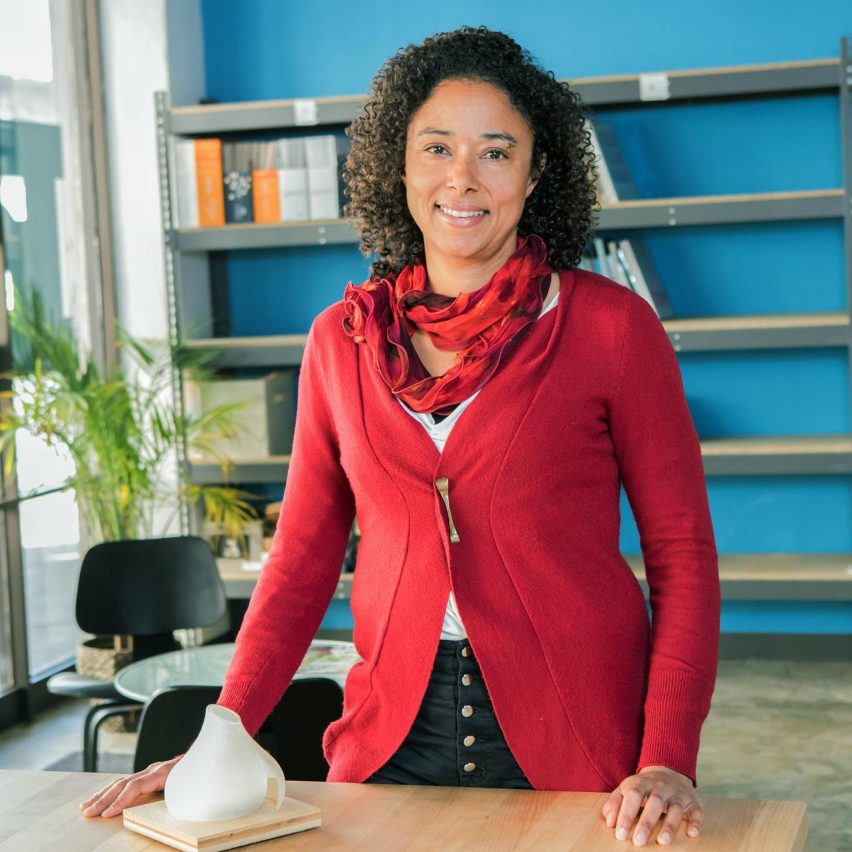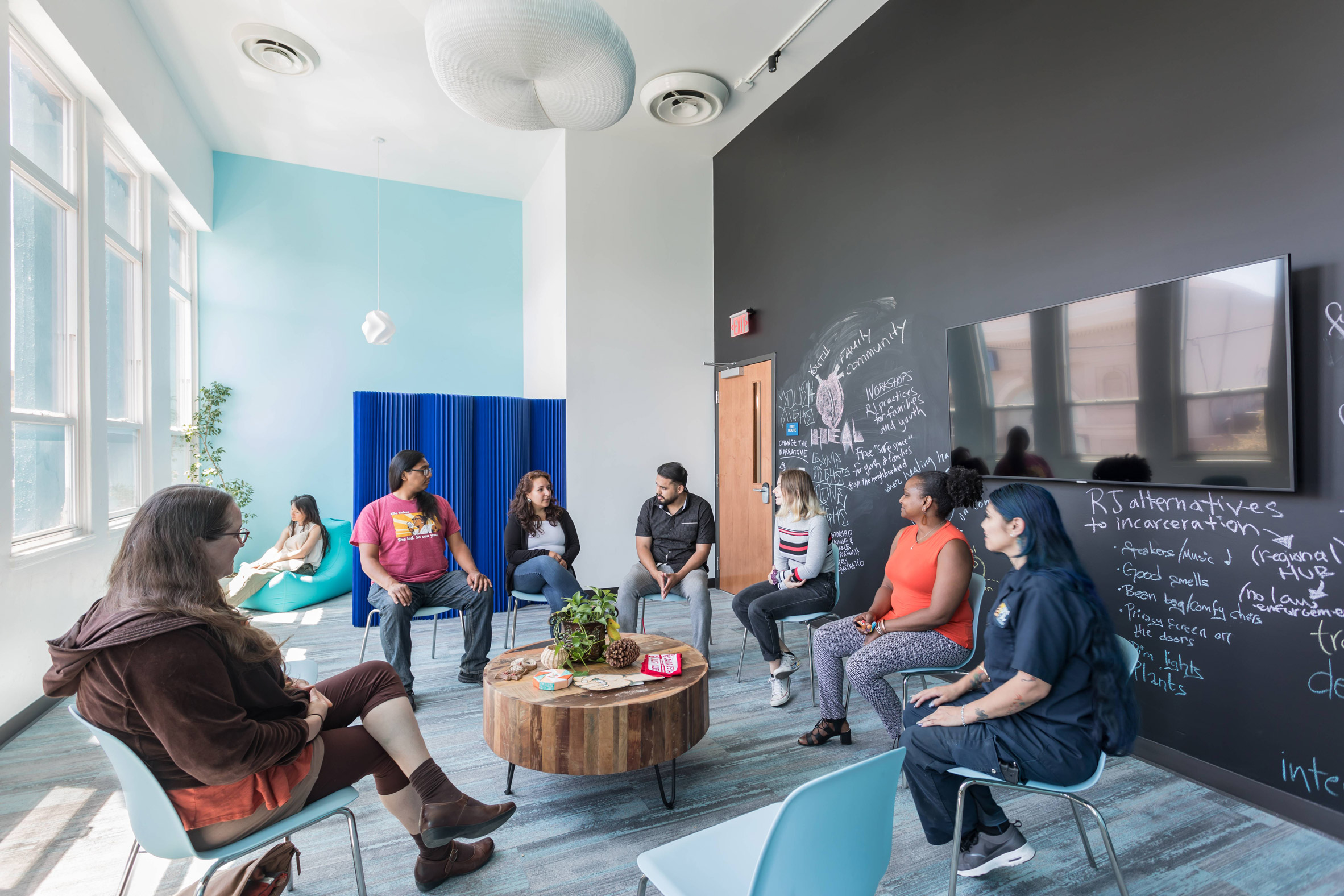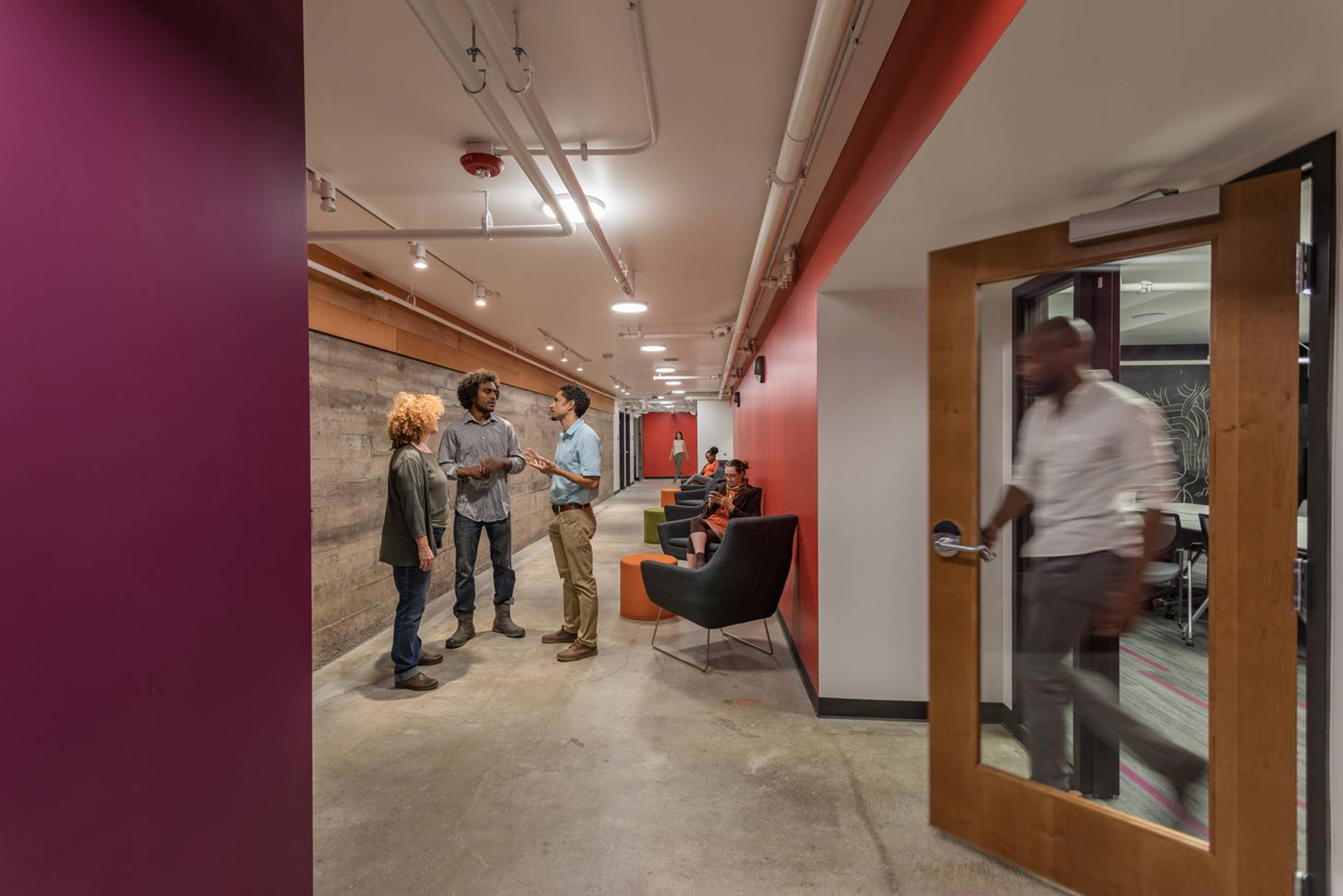
Architects need to be designing new building typologies to replace prisons that "were built to hurt people", says architect Deanna Van Buren, who established her non-profit firm to bring an end to mass incarceration in America.
Van Buren told Dezeen the current infrastructure designed for the criminal justice system does not work and that architects should instead be focusing on creating new building types.
"Prison represents punishment and control and security," she said. "They're not about care. They're not about rehabilitation. They're not about restoration."
"Don't worry about making those prisons and jails better, there's a whole lot of infrastructure that has to get built to end mass incarceration."
Communities "just want to demolish" prisons
Van Buren founded her Oakland practice Designing Justice + Design Spaces in 2011 with the aim of building spaces that help to bring an end to mass incarceration in America, where more people per capita are incarcerated than any other country.
Her firm designs spaces for restorative justice, in which the damage of a crime is mended through meetings between the victim and the offender.
It also works on redesigning existing prions and jails. However, she believes that these structures are often too difficult to repurpose, making demolition a better option.

"Even the work we're doing to reimagine or repurpose prisons and jails is very hard to do because they were built to hurt people," she said.
"We're finding even with our community organising partners, they just want to demolish them, and I can't say that's not the best solution. I honestly can't say it's not the best way to move forward sometimes because they're so difficult to repurpose."
Van Buren believes that by continuing to design prisons, architects are contributing to a "racist structure" in which African Americans are incarcerated at over five times the rate of white people, according to the National Association for the Advancement of Colored People.
Her remarks echo those of architectural designer Michael Ford, who said architects should stop designing jails and prisons if they want to really impact the fight for racial equality.
"Architects have to rethink their business models"
For architecture studios to implement change they may have to rethink their business practices and focus less on making profit from wealthy clients said Van Buren.
"Architects have to rethink their business models," she said. "You know that you're a for-profit entity and you're taking money from wealthy clients and you might have to start to rethink how you do things so that you can practice in a way that's more equitable."
"Architects also have to do some inquiry, they really need to do their own unconscious-bias inquiry, they need to understand the context within which we're living, they need to question the systems that they're working for," she added.
Van Buren's firm has completed several projects that demonstrate the ideals of restorative justice including Restore Oakland, which is billed as "the first centre for restorative justice and restorative economics".
The centre features spaces for Alameda County's restorative justice system and incubators for businesses from low-income communities of colour.
The firm is also transforming The Atlanta City Detention Centre into the Center for Equity for the local community, which will including facilities for wellness facilities, skills-building and crime prevention, and pop-up rooms offering halfway houses for people re-entering communities.

Van Buren is now developing these ideas into a larger concept for Detroit, which is a campus that will include housing, fabrication spaces, workforce development space and non-profit office space.
"It's really a holistic approach to development that brings communities what they actually need so we can cut the pipeline to prison at the root of it," she said. "Those projects really matter."
Below is an edited transcript of the interview with Van Buren:
Eleanor Gibson: Could you start by telling me a bit about yourself, how you got into architecture and what Designing Justice + Designing Spaces is?
Deanna van Buren: I wanted to be an architect since I was nine years old. It was so obvious. And then, you know, I practiced professionally for maybe 10 years in a more traditional context as an architect.
I noticed that in the early 2000s people were not just practicing anymore for the wealthy, but the other 99 per cent. I wanted to do that. It took a while, but I started my firm in 2011 with a sort of intense focus on designing for restorative justice.
I started my own design studio realising that, while we could design things, and make some beautiful, pictures, we didn't know how to pay for them. The things that we were thinking about were new, there was no financing structure for it, no traditional way of paying for it. We had to start to think about the real estate development aspects of the work and the financing aspects of work as well as the design. That's how Designing Justice + Designing Spaces became what it is today. We formed a non-profit of both real estate developers and architects.
Eleanor Gibson: What is restorative justice? And how does that look in terms of architecture and design?
Deanna van Buren: Restorative justice is a philosophy that instead of what we do now, where it says a crime has been committed, who wants to be punished? It's a crime against the state. Restorative justice says that there's been a breach of relationships and that the person who's been harmed is the focus and their needs must be met and that those who have committed the offense are accountable for that, and they have an obligation to make amends and repair the damage if possible.
The environments we've created and developed are much softer
So that brings them together in pretty intense dialogue, where they create a plan to address the offender's conduct so that people can move forward. It can be used in a whole range of cases, everything from murder to sexual assault. It's been used all over the world, they are old practices.
When we go look at what they look like, it really kind of depends on the culture within the context of which you're working. You have to look at what the cultural context is, and begin to work with people to start to understand, where do people most feel comfortable coming into intense dialogue like that? What qualities does the space have to have?
And so in the work that we've done, the environments that we've created and developed are much softer than the sort of institutional environments that we see when you think of a courthouse for example. The place we did in Syracuse has a domestic feeling. There's always a kitchen, food matters. You know, like when the last time you got excited to go to the courthouse to get some great food, right? They don't go together.
Restorative justice is part of the process. The reintegration of landscape and nature into the environment is really important because of the way it supports our nervous system, you need to have objects and colour and texture to touch and to look at that also helps the nervous system. If you've ever been in a conflict you know you go into fight-flight freeze, because that's just sort of our natural biological instinct. You want to support that in the environment, by providing places for people just to calm down.
There are a lot of things that you need to do but these are some basic strategies that can get embedded into the place. And also they just feel very domestic. It's much cheaper and easier to make an environment like that than to build a courthouse.
Eleanor Gibson: Recently there's been more of an emphasis on calling for an end to mass incarceration in America. How do you see architects playing into that? How can they be proactive?
Deanna van Buren: There's a lot, a lot, a lot of things to do. I mean, this is what I've said, like, don't worry about making those prisons and jails better, there's a whole lot of infrastructure that has to get built to end mass incarceration.
I'm working on documents that will outline what a lot of these building types are. And, you know, I'm up to 60 building types you have to create, so get ready. There's a lot to do. Right? You don't need to worry about that. There's plenty of work for all of us.
Are you gentrifying neighbourhoods through your actions? Are you building out racist structures?
Architects also have to do some inquiry. They really need to do their own unconscious bias, inquiry, they need to understand the context within which we're living, they need to question the systems that they're working for, like if you take on a client, who is this project for? Who are you accountable to, if you begin to engage was harmed by the quiddity harms? Are you gentrifying neighbourhoods through your actions? Are you building out racist structures in your building?
Those are a lot of questions that have to happen in terms of execution of your work and architects have to rethink their business model. You know that you're a for-profit entity and you're taking money from wealthy clients. And you might have to start to rethink how you do things. So that you can practice in a way in a way that's more equitable.
Hopefully, our system will just become more difficult. But there, you have to begin to work for folks who don't, who don't have anything, and who have been marginalised and oppressed for a long time. I'm accountable to the people I work for. And I have to be clear about my goals and intention, and be really careful about the way that I work, which means really engaging them in the process. So I do a lot of community engagement work.
Eleanor Gibson: For some people a world without prisons or jails might seem kind of inconceivable. How would you describe it working? Is it possible?
Deanna van Buren: I think we're seeing now that it is quite possible. And that, you know, you look at a jail, for example, some of the jails across the country, they're letting out 60 per cent of the population. So if you can do that, in a month or two, why were they in there in the first place?
So it just raises a lot of questions, as I think over 70,000 people were released out of our institutions. And there was a time where we had just a fraction of the people we see in there today. I'm curious about in the future.
There will be probably some people who do need to be separated from society. And then what is that place that you create for them? I don't think it's a prison. I think it would be something else that's quite different. And you would call it something different and would function differently.
If you look to New Zealand, where they really instituted restorative justice for over 20 years, they're just not building them anymore. They don't use incarceration at all. And you see this decline in the building of that infrastructure, we don't need it anymore. We didn't used to have them. These are relatively new building types if you look at the history of humanity. And they're not effective and they don't work, and now we realise we have a public health issue so we can do something different.
Eleanor Gibson: Can you tell me a bit about some of the projects you're working on like the Atlanta City Detention Center.
Deanna van Buren: We have three types of projects that we do. The Atlanta City Detention Center is an example of our repurposing and reimagining work. And that is we support municipalities, organisers, to close facilities and repurpose them or reimagine them whether you demolish them. They'll do feasibility studies on what you can do. And that's something that we do around the country.
Right now we're building out something call mobile refuge rooms
The second bucket of work we call restorative reentry. So that's trying to build out the infrastructure to support folks re-entering their communities from prison and jail. That is everything from sort of mobile infrastructure to working on campuses, and right now we're building out something call mobile refuge rooms, which are pop-up rooms for folks reentering the community that give privacy and dignity because they don't really have that right now. Often they'll come and they're 10 in a room, it's not safe. They're really not. They're really not nice institutions.
These environments we had been building but now of course of Covid-19 is more necessary than ever because there's just more people coming out. They're also great for social distancing and for observation and quarantining. So we're working on those.
And then the third bucket, which is most of our work is restorative reinvestments in community. Where we need to really focus right now is things like Restore Oakland, the country's first centre for restorative justice restorative economics. The community owns the building and there are spaces for restorative justice spaces for people to get job training. They need a job, they need education, spaces for the community to organise. And so that was completed last year.
Now we're about to start a new project in Detroit. We're buying the land and we will be developing a concept like that to be an entire campus of buildings that are going to be able to support daily needs like retail to hyper urgent housing for folks coming out of prison, to fabrication spaces and workforce development space and nonprofit office space.
If we get the financing right, the community can invest in the project, so they have equity, right. It's really a holistic approach to development that brings communities what they actually need. So that we can cut the pipeline to prison at the root of it and those projects really matter. They can impact on our models, others to copy.
Eleanor Gibson: You talked about a racist structure, what do you mean by that?
Deanna van Buren: The systems that we have, our criminal justice system, our educational system, our healthcare system, structural racism is embedded into these systems. As a nation and globally, hopefully, have we have started to wake up to that as a fact.
So what happens is we just build that right there, the things that we believe about people, things we believe as a society, get built, get put to the built environment, and we can see that in all forms of architecture.
Trump's decision to say all of our government architecture needs to be in the Federalist style reinforce those structural systems in our architecture. It's very, very monumental and a representation of power and who's in power.
If you demolish it and they're not there anymore, what would that do to stop this?
Prison represents punishment and control and security. They're not about care. They're not about rehabilitation. They're not about restoration. Those are a different set of values or beliefs that will look quite different.
One of the challenges we have now is to unbuild that. Even in the work we're doing to reimagine or repurpose prisons and jails is very hard to do because they were built to hurt people. And so we're finding even with our community organising partners they just want to demolish them, and I can't say that's not the best solution. I honestly can't say it's not the best way to move forward sometimes because they're so difficult to repurpose. What happens is, even when they close them down, they become immigration detention facilities, right, because that's what they're built to do, to detain.
If you demolish it and they're not there anymore, what would that do to stop this? So, you know, I'm torn and we look at both things, but you can sort of see how things get so rigidly built. Architecture is, you know, it's really there. It's hard to take it down once you got it up.
Photography is by Emily Hagopian.
The post "A whole lot has to get built to end mass incarceration" says Deanna van Buren appeared first on Dezeen.
from Dezeen https://ift.tt/37YUR3M
No comments:
Post a Comment